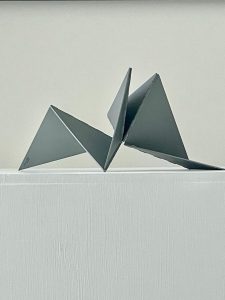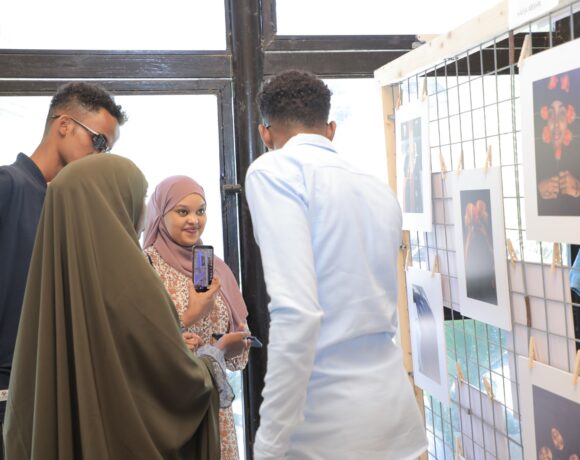Alejandra Castro Rioseco is a Chilean civil engineer, philanthropist and patron of the arts, although she became a citizen of the world very early on. It is difficult to determine where a person comes from when her life takes place in such distant places full of contradictions: United States and Dubai. For this very reason, the collector feels cosmopolitan and close to cultures that are also very different from each other. Alejandra Castro Rioseco graduated in civil engineering at the behest of her family, especially her father, who was trying to ensure a secure future for his daughter. However, the engineering profession never convinced her, so much so that she never practiced, opting for philanthropy, an aspect of art that was instilled in her from childhood. Gradually she then turned to art collecting, attending more and more museums, galleries and reading what she could. Therefore, she has been involved in art collecting for about fifteen years – a third of her life. In these years she has deepened her passion, specializing in 2019 in women’s art, and also being part of the team of El Museo del Barrio and the Solomon R. Guggenheim Museum, among others. She currently collaborates with various cultural institutions, especially museums in west Asia. Progress toward social equality and the promotion of culture have always been her two great aspirations within this field; indeed, throughout the 21st century she has founded women’s rights associations, participated in various battles to achieve social equality, and succeeded in obtaining state funding for the creation and improvement of public places such as schools or theaters. Her successful and vindictive, feminist and democratic temperament led her to win several supporters on the one hand, but also many others who discredit her. Today, however, she does not allow herself to be overly carried away by the judgment of others. The weight of her professional team’s criteria is very high, and Castro Rioseco constantly seeks advice to sponsor good art.
The MIA Art Collection has thus become a key pillar in protecting the careers of many women artists, giving them space to work and show their work, granting them public presence and speech. Likewise, the acquisition of works is capital – the collection houses more than nine hundred pieces – and goes hand in hand with the important recognition of artists at the market level. Let’s find out more about Alejandra Castro Rioseco and the MIA Art Collection through an interview.
Andrea García Casal: Collecting encompasses a multitude of possibilities, in what way has art in particular become one of your goals, albeit coming from a world as distant as engineering?
Alejandra Castro Rioseco: I don’t come from the engineering world. I studied engineering, which is different. I come from the world of emotions, sensitivity, social… To continue on the path of art was a natural step. Growing up and understanding this world came naturally to me. I think understanding human emotions is part of understanding art, its history and, of course, what it means.
By focusing on women’s art, you are fighting against the system of patriarchy, which is applied to all spheres of humanity. In what aspects have you noticed greater inequality compared to art made by men?
I see inequality in every corner, in every exhibition, in every art event. Women in art are always put under the gun and it doesn’t matter if they are curators, artists or collectors. Inequality has a very subtle bias between the visible and the invisible. It is present and art is no exception; women have to prove everything, we have to justify every choice, in contrast men have held power for centuries. I don’t even want to go into the details of the persons who support this inequality, because they are terrible, I prefer to focus on what we are going to do to change this situation, and I feel that the last Venice Biennalewas a big step, a strong breakthrough for women, exhibiting a high percentage of women artists and creating work for many women curators and insiders in different areas of contemporary art. I would like to believe that we can improve from there with the support of other women who understand the value of equality.
What are your references in the art world?
There are many women who inspire me. I don’t know if they are role models, but they are women and organizations that have done incredible things. This is the case with the Delfina Foundation, the life of its founder has been entirely dedicated to art; or I could mention the art patron Patricia Phelps de Cisneros and her extraordinary philanthropic work with art museums all around the world; but also the Italian Patrizia Sandretto who has succeeded impeccably in running the Fondazione Sandretto Re Rebaudengo, with that family seal that I wish I could achieve in the future. On our side, by the way, there are the women we honor every year within the MIA Art Collection award. There are a lot of women who give a lot of work to art, and very little is really known about many of them; the support network for women is weakening right now. Finally, I have to say that my forever heroine, my constant reference and inspiration is Peggy Guggenheim, one of those responsible for saving contemporary art. In her own way and at a very difficult time, she dedicated her life and resources to art, and that is commendable.
We know that the MIA Art Collection’s committee of experts is crucial. Has your team remained fixed since your beginnings as a collector or has it grown, even changing its components?
MIA has a curatorial committee that changes from time to time with the goal of making room for new faces, new ideas, new thoughts. That’s why it changes every day, like the people. Our ideas are taking different forms, and the curators who come through MIA know this, they know our way of working, which is different from traditional models. We want our people to feel free to do what they want, of course always within the agreements and values of MIA. Our team travels, interacts with other cultures, exchanges ideas and grows and this makes us immensely happy, it is like watching a woman grow.
Have you ever considered leaving visual arts advocacy to start supporting women in the performing arts with the MIA Art Collection? I ask this question because I know you are also passionate about and promote music, dance and theater.
I always support other institutions. I do it with the José Limón Dance Foundation or with The International Federation of Chopin Societies, and I do it with the same strength that I put into MIA Art Collection because this project is also a family platform that we are all entirely dedicated to. I always hope, though, as an art lover, that I can continue to collaborate with incredible organizations like the ones I mentioned. The arts are a collection of talents and aiming for a balance among all of them is also important.
Are there any Italian women artists in your collection, or do you plan to acquire Italian works in the future?
We are interested in acquiring the work of women from all over the world. However, especially in the case of Italy, more than the country of origin, we want to focus on the figure of a well precise artist and her role in art, as this country has a long history of women in the art, which is why we love it and find it always at the forefront of art, just as with regard to the last Venice Biennale, which I have already mentioned, and which has become the center of the whole art world in this period.
Does MIA Art Collection, in addition to acquiring works, holding exhibitions or conferences, also focus on activities of interest to the education and promotion of artists, such as offering the possibility of art residencies or scholarships?
Of course, MIA has very clear pillars: the MIA Anywhere virtual museum, the exhibitions, the scholarships, the awards and the annual gala. This is what we do every year. Now we are working on the residency project because we think it is essential to be able to give artists a space and a time where they can grow and create in a protected situation. We are also looking at virtual models to continue this work on supporting women.
What are MIA Art Collection’s thoughts on the role of arts organizations and institutions in respecting the context of women?
We see institutions moving very slowly toward an equality. We understand that there is a complex social contingency in the world, but we observe with great sadness how many museums and similar platforms are easily overcome by obstacles, inevitably maintaining the gap between men and women. This always makes us rethink the organizations and the artists we support to ensure that our contribution transcends and transforms, as much as possible, this complicated world into a more supportive and egalitarian environment.
Andrea García Casal
Info:
Alejandra Castro Rioseco, MIA Art Collection
https://miaartcollection.org
Cover image: Conference El precio del arte, organized by MIA Art Collection, Feria Internacional de Arte Contemporáneo, ARCOmadrid, 2022
 Alejandra Castro Rioseco, portrait. On the background: Catalina Mena, El peso de las alas, serie, 2018. Courtesy MIA Art Collection
Alejandra Castro Rioseco, portrait. On the background: Catalina Mena, El peso de las alas, serie, 2018. Courtesy MIA Art Collection
 Alejandra González, Mar de fondo: presencia, 2018. Courtesy MIA Art Collection
Alejandra González, Mar de fondo: presencia, 2018. Courtesy MIA Art Collection
 Alejandra González, Mar de fondo: ausencia, 2018. Courtesy MIA Art Collection
Alejandra González, Mar de fondo: ausencia, 2018. Courtesy MIA Art Collection
 Alejandra Castro Rioseco awarding the gallery owner Leila Heller. The MIA Art Collection Gala Dinner & Awards 2022. Bulgari Hotel & Resorts, Dubai
Alejandra Castro Rioseco awarding the gallery owner Leila Heller. The MIA Art Collection Gala Dinner & Awards 2022. Bulgari Hotel & Resorts, Dubai
 Lygia Clark, Bichos, series, 1960 c. Courtesy MIA Art Collection
Lygia Clark, Bichos, series, 1960 c. Courtesy MIA Art Collection

is a contemporary art magazine since 1980






NO COMMENT